 THE ECONOMY OF THE
SOUTH
THE ECONOMY OF THE
SOUTH
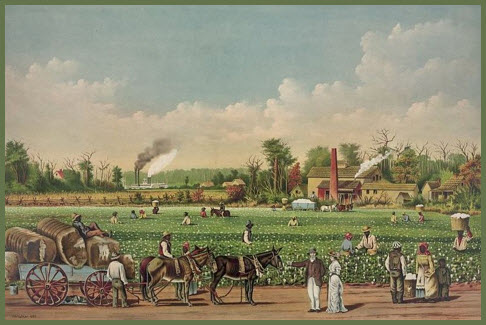
Lithograph of a
Cotton Plantation on the Mississippi River
Unit
Overview
By
the middle of the nineteenth century, the American South had built a thriving
economy, and its wealth was greater than any country in Europe with the
exception of Great Britain.† Unlike the
North, the basis for the regionís financial achievement was agriculture and,
more specifically, the cultivation of cotton.†
However, much of the Southís success was derived from the labor of
enslaved Africans.† Letís see how it all
happened.
The
Upper and Deep South
In
colonial times, most southerners lived along the eastern seaboard in Maryland,
Virginia, and North Carolina, a region that later became known as the Upper South.† As the number of settlers increased, they
moved beyond the coastal plains into the Deep
South, an area made up of Alabama, Mississippi, Louisiana, Georgia, South
Carolina and Texas.† Although both the
Upper South and the Deep South relied on agriculture, their economies developed
in different ways.† The Upper South
focused on tobacco, wheat, hemp and vegetables, while the Deep South emphasized
cotton, rice, indigo and sugar cane.†
Movies and novels have encouraged the American public to envision the
South as a series of massive plantations worked by hundreds of slaves.† In reality, some parts of the South included
mountains and forests that were unsuitable for plantation farming.† Less than 1% of southerners kept more than
fifty slaves, and the average property owner was more likely to live in a log
cabin rather than a luxurious mansion.
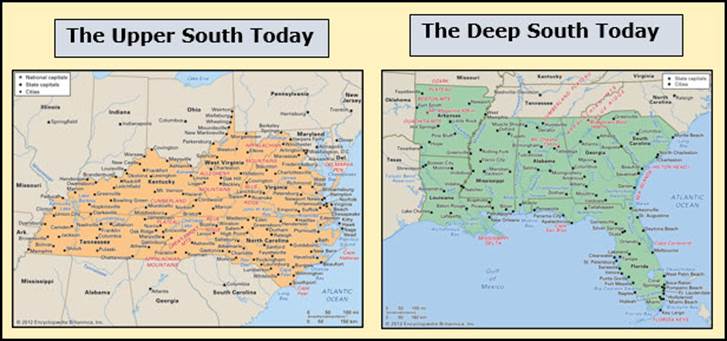
 † Go to Questions 1 through 3.
† Go to Questions 1 through 3.
King
Cotton
The Industrial Revolution inspired new
textile mills and an interest in machine-made cloth.† This increased the demand for raw cotton
fiber.† Although well-suited to the
climate of the American South, cotton proved to be a difficult crop to prepare
for market.† Cotton plants produced
hundreds of small, sticky seeds that clung to the fibers.† These had to be removed before sending the
cotton to market.† The work was so
tedious that the average worker could only clean about one pound a day.† This changed in 1793 with the invention of
the cotton gin by Eli Whitney.† Using this machine, a worker could clean
fifty pound of cotton per day.† It was
also small enough for one person to carry.†
Plantation owners increased the amount of cotton under cultivation, and
soon the Deep South was producing 60% of the worldís supply.† About 30% of the cotton grown in the U.S.
went to northern factories, while British textile firms purchased most of the
remaining 70%.† By 1860, cotton made up
one-half of the goods exported to foreign countries by the United States.
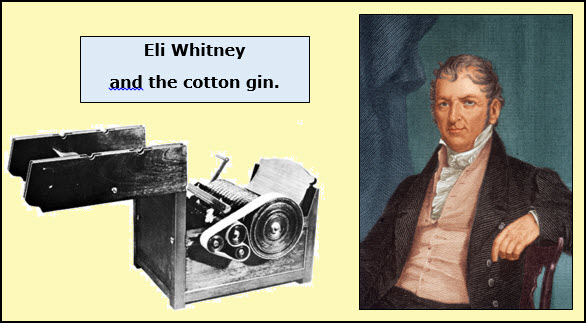
Like
all property owners, cotton plantation owners had regular expenses, such as the
purchase of seed and equipment.† These
were referred to as fixed costs
since they involved about the same amount of money annually.† Cotton prices, however, were dependent on the
market and varied from season to season.†
In an attempt to receive the best return, planters sold their cotton to
agents in New Orleans, Charleston and other southern cities.† The agents, who arranged to store the cotton
in warehouses until it reached what was believed to be its highest price,
conducted business in buildings known as cotton
exchanges.† In the meantime, agents
extended credit in the form of loans to the planters.† Because the planters did not receive payment
until the cotton was traded, the majority of southern plantation owners were
continuously in debt.
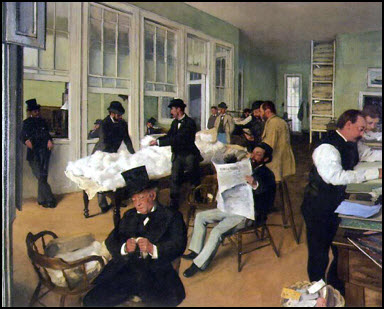
Cotton Office in the New Orleans Exchange:† Edgar Degas, 1873
Debt
discouraged southern farmers and plantation owners from supporting new taxes
for government-funded projects, such as better roads and public schools.† It also meant that there was less money to
invest in private companies for the construction of canals and railroads.† In 1860, only one-third of the nationís
railroad lines were in the South, and most of them were short runs used to
transport cotton to market.† For the
South, the regionís lack of railroad track would prove to be a major
disadvantage during the Civil War.
 † Go to Questions 4 through 8.
† Go to Questions 4 through 8.
Southern
Society
As
in the North, white southern society could be pictured in the shape of a pyramid.† Planters who owned the most land and the most
slaves formed the upper class and represented about 3% of all southern slave
holders.† Although most built homes
comparable to large farm houses, some lived in beautiful mansions and imported
fine furniture from Europe.† They hired
tutors for their children or sent them to boarding school.† Household slaves took care the personal needs
of the planterís family.† Because they
were often in debt, well-to-do plantation owners measured their wealth by the
amount of land they owned, the number of slaves they had and the material goods
they possessed.†
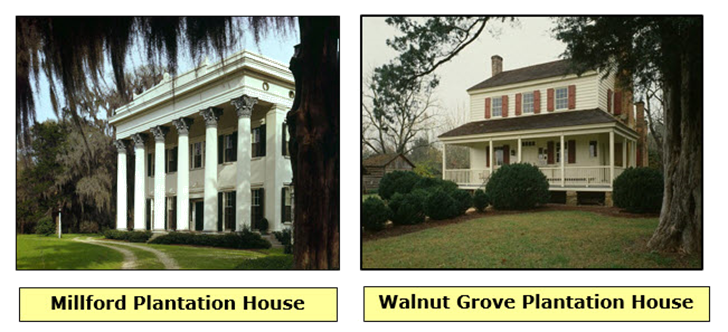
Below
the planters on the social scale were farmers who owned smaller properties and
fewer enslaved Africans.† The majority of
white southerners, about 75% of the population, did not own slaves.† Called yeomen,
they worked their own farms, grew their own food and raised livestock.† Some families rented land for a share of
their crops and labored as tenant farmers.†
The poorest whites cleared what land they could on the edge of the
forests and fed their families by hunting game.†
The Reality
When
a southern property owner died, the land was usually handed down to his oldest
son.† Therefore, younger sons had to
choose other careers or professions.†
Some became lawyers, doctors or military officers; others made a living
as manufacturers.† On a much smaller
scale than their northern counterparts, a few southerners were operating
textile mills, flour-processing companies, lumber yards and iron works by
1860.† For example, Joseph Reid Anderson
took over the Tredegar Iron Works
located near Richmond Virginia in 1840.†
He turned it into one of the nationís leading producers of iron within a
few years.† However, agriculture
continued to be the focus of southern economy and society.
 † Go to Questions 9 through 12.
† Go to Questions 9 through 12.
Slavery
in the South
By
the mid-1800s, between 3.5 and 4 million people of African descent lived in the
American South.† In 1808, Congress passed
a federal law prohibiting the slave trade, but this legislation did not outlaw
the buying and selling of slaves within the United States.† As the production of cotton and other cash
crops expanded, the demand for slaves in the Deep South increased.† The price that planters were willing to pay
for slaves also increased.† Slave traders
were determined not to lose out on this opportunity to make profits.† †
Because
they could no longer bring enslaved Africans into the country legally,
professional slave traders had to find new sources for marketable slaves.† Since the children of slaves shared their
parentsí status, they were considered property and were often put up for sale
by their owners.† For African Americans,
the separation of families was one of the most dreaded aspects of slavery.† Another source of marketable slaves was the
Upper South.† Because some areas of
Virginia and Maryland had been farmed in the same way for almost two hundred
years, the soil was wearing out.† It was
no longer economical or practical to keep slaves, and their sales resulted in a
handsome profits.† Therefore, these
farmers chose to sell their slaves rather than to free them.† Slave traders then offered them at auction to
planters in the Deep South.
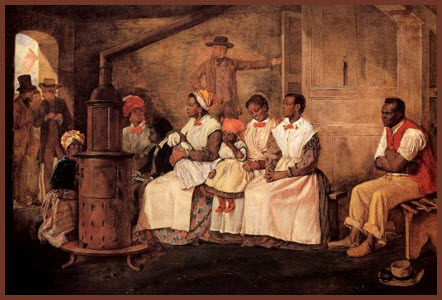
Slaves Waiting
for Auction:† Painted from a sketch made
in 1853
During
the American Revolution, a small number of enslaved Africans in the South had
been given their freedom.† Most worked
for very low wages at unskilled jobs in southern cities or as farm hands.† A few eventually were able to buy land and
owned slaves.† Sometimes they purchased
members of their families at auction to free them.† The Metoyer
family of Louisiana is a rare example of an African-American ownership of a
large plantation.† They owned thousands
of acres and over 400 slaves.†††
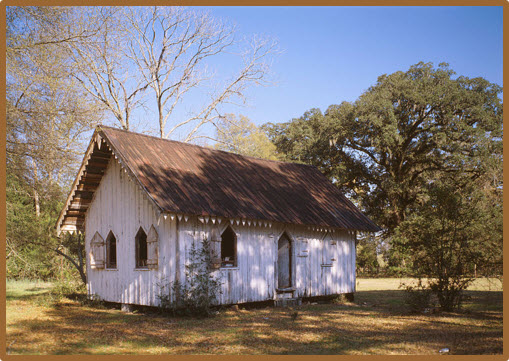
Slave Cabin:†
Arundel Plantation, South Carolina
Even
though they faced hardships and uncertainty, slaves remembered and practiced
many African customs.† They told folk
stories to their children and sang songs from their homeland.† Traditional dances were handed down to new
generations of African Americans.† Many
slaves accepted Christianity, but they also continued to follow the religious
practices of their African ancestors.
 † Go to Questions 13 through 15.
† Go to Questions 13 through 15.
Resisting
Slavery
Since
the 1700s, slave owners took threats of rebellion very seriously.† To prevent such an event, most southern
states passed a series of black codes.† These laws became stricter and more numerous
between 1830 and 1860.† Throughout the
South, it was illegal for enslaved Africans to assemble in large groups or to
leave their masterís property without a pass.†
Black codes also made it a crime to teach slaves to read and write,
because white southerners believed these skills made them more likely to
revolt.
In
spite of determination to prevent them, there were anti-slavery
rebellions.† You can learn about several
of them by watching the video listed below.†
The most famous one took place in Virginia in 1831.† Nat
Turner, a religious leader popular among his fellow slaves, led his
followers in a violent attack that resulted in the deaths of fifty-five
whites.† Turner was hanged, and white
southerners imposed even stricter black codes.†
Because most slaves realized that an armed uprisings like Turnerís
Rebellion had little chance of being successful, they looked for other ways to
resist.† Some slaves protested by
performing their tasks very slowly or by pretending to be ill.† Breaking tools and occasionally setting
plantation buildings on fire were also used in attempts to gain some respect
from the white community.
 † Go to Questions 16 through 18.
† Go to Questions 16 through 18.
Making
an Escape
Some
slaves hoped to change their lives by running away.† Sometimes this involved short distances to
search for a relative or to escape a harsh master.† A few, however, hoped to gain their freedom
by escaping to the North.† This was a
dangerous and complicated undertaking, especially from the Deep South.† Those who succeeded were mostly from the
Upper South and had help from the Underground
Railroad.† The Underground Railroad
was not underground, and it was not a railroad.†
Operated by free blacks and whites who opposed slavery, it was a network
of escape routes that enabled runaway slaves to move secretly from one safe
house to another.†
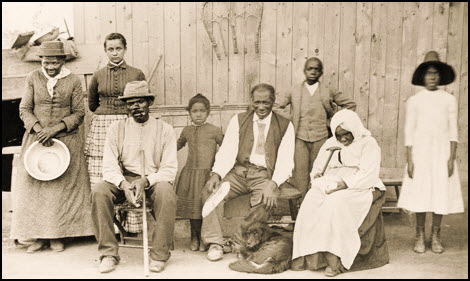
Harriet Tubman and a Group of Escaped Slaves
Harriet Tubman was one of the
runaways to complete the journey.† Born a
slave in Maryland, Tubman made her break for freedom when she was thirty years
old.† She returned to the South nineteen times
to help others escape.† Although southern
officials offered a reward for her capture and arrest, she continued her work
and died a free woman at the age of ninety-three.† Her life story is described in the video
listed below.† Unlike Tubman, however,
most runaways were unsuccessful.† When
captured, they faced severe punishments, such as whippings or beatings.†
![]() †
Harriet Tubman and her Escape to Freedom
†
Harriet Tubman and her Escape to Freedom
 † Go to Questions 19 and 20.was
† Go to Questions 19 and 20.was
What
Happened Next?
During
the first half of the nineteenth century, a growing number of Americans decided
that slavery was wrong.† They formed
societies to support their cause and demanded change.† The anti-slavery movement drew sharp
criticism from not only southerners but from northern factory workers, who
feared that an influx of former slaves would threaten their jobs.† Could the issue of slavery be resolved?† Did the anti-slavery movement actually help
enslaved people?† Before moving on to
explore these topics in the next unit, review the names and terms found in Unit
30; then, answer Questions 21 through 30.
 † Go to Questions 21 through 30.
† Go to Questions 21 through 30.
 |
| Unit 30 The Underground Railroad |
| Unit 30 Mount Vernon and the Dilemma of a Revolutionary Slave Holder Article and Quiz |
| Unit 30 What's the Big Idea? Worksheet |